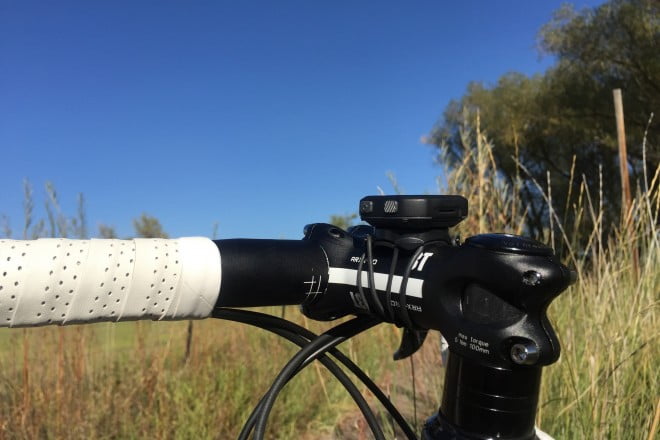MSRP: $130
We like: Compact GPS computer for essential training data.
We don’t like: Lacks Bluetooth and ANT+ capabilities.
A compact and capable GPS computer can be difficult to find if you want to track basic training data like ride time, distance, and speed without a bulky device or hefty price tag. This year, Garmin introduced the Edge 20, a GPS-enabled computer that provides an assortment of riding metrics — essentials and nothing more — in a small, intuitive, and affordable package.
Measuring approximately 4cm by 4cm, and weighing just 25 grams, the Edge 20 is the smallest GPS computer we’ve seen. Lezyne’s Mini Computer rivals this modest footprint, but the Edge 20 offers Garmin’s host of intuitive user settings. Useful functions carried over from previous Garmin devices include auto lap for designated distances or times, auto pause when stopped at traffic lights, and an indoor training setting when GPS isn’t needed.
Three external buttons guide navigation between the device’s interchangeable data screens and make it easy to select different functions when riding. While some more advanced cycling computers often use touch screens to navigate settings, we prefer feeling the click each time we press of the Edge 20’s buttons.
After finishing a ride, it was simple to upload Edge 20 files to the online Garmin Connect platform where Garmin users can share ride details with friends or track and analyze training data. This process took less than five minutes between getting off the bike and seeing our numbers on the screen. Using Garmin Connect, we created new routes and downloaded courses onto the device for turn-by-turn navigation while on the move. Garmin Connect can also be configured to sync files with Strava.
At $130, the Edge 20 is competitively priced for a small GPS computer with basic functions. Cateye’s Stealth Evo GPS computer offers similar features for the same price while Lezyne’s mini computer costs $140.
Garmin’s Edge 25 is priced at $170 and it offers a suite of more comprehensive metrics and additional connectivity that we think is worth the extra $40. The more capable Edge 25 includes ANT+ technology, allowing it to pair with heart rate straps and cadence sensors for additional data collection. The Edge 25 also has Bluetooth connectivity to display notifications from a smartphone, such as incoming calls and texts. Plus, the Bluetooth allowed for wireless data transfer between the device and smartphones for easy tracking with the Garmin Connect app. Unfortunately, the Edge 20 cannot pair with ANT+ devices and it requires a USB connection to upload or download training data and courses.
While Garmin’s Edge 20 answers the minimalists’ plea for an unobtrusive cycling computer with ample training data and none of the bells and whistles, it left us wanting for just a little bit more connectivity. If easy data transfers and more complex training info are high on your list, spend the extra money and choose the Edge 25.
[“source-velonews”]

 The slim Edge 20 computer measures 4cm by 4cm for an unobtrusive way to collect ride data. Photo: Kristen Legan
The slim Edge 20 computer measures 4cm by 4cm for an unobtrusive way to collect ride data. Photo: Kristen Legan Despite its small footprint, the Garmin Edge 20’s screen is easy to read with large, clear data numbers. Photo: Kristen Legan
Despite its small footprint, the Garmin Edge 20’s screen is easy to read with large, clear data numbers. Photo: Kristen Legan The Garmin Edge 20 has three small buttons for easy navigation between screens and functions. Photo: Kristen Legan
The Garmin Edge 20 has three small buttons for easy navigation between screens and functions. Photo: Kristen Legan